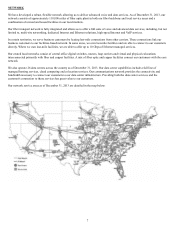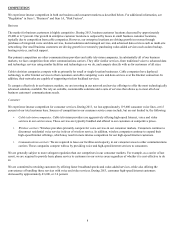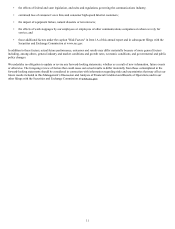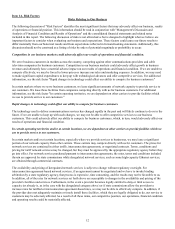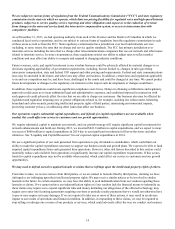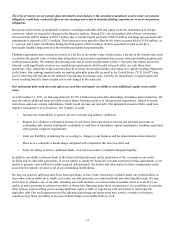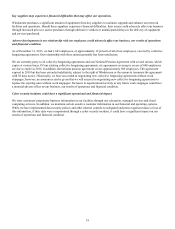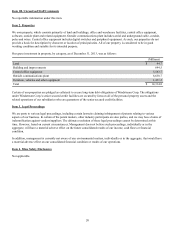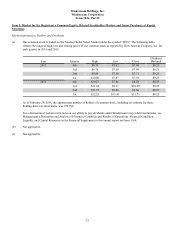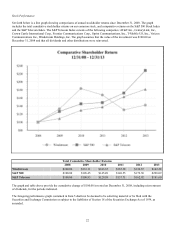Windstream 2013 Annual Report Download - page 110
Download and view the complete annual report
Please find page 110 of the 2013 Windstream annual report below. You can navigate through the pages in the report by either clicking on the pages listed below, or by using the keyword search tool below to find specific information within the annual report.
12
Item 1A. Risk Factors Risks Relating to Our Business
The following discussion of "Risk Factors" identifies the most significant factors that may adversely affect our business, results
of operations or financial position. This information should be read in conjunction with "Management's Discussion and
Analysis of Financial Condition and Results of Operations" and the consolidated financial statements and related notes
included in this report. The following discussion of risks is not all-inclusive but is designed to highlight what we believe are
important factors to consider when evaluating our business and expectations. These factors could cause our future results to
differ materially from our historical results and from expectations reflected in forward-looking statements. Additionally, this
discussion should not be construed as a listing of risks by order of potential magnitude or probability to occur.
Competition in our business markets could adversely affect our results of operations and financial condition.
We serve business customers in markets across the country, competing against other communications providers and cable
television companies for business customers. Competition in our business markets could adversely affect growth in business
revenues and ultimately have a material adverse impact on our results of operations and financial condition. If we are unable to
compete effectively, we may be forced to lower prices or increase our sales and marketing expenses. In addition, we may need
to make significant capital expenditures to keep up with technological advances and offer competitive services. For additional
information, see the risk factor "Rapid changes in technology could affect our ability to compete for business customers."
In certain markets where we serve business customers, we lease significant amounts of network capacity to provide service to
our customers. We lease these facilities from companies competing directly with us for business customers. For additional
information, see the risk factor "In certain operating territories, we are dependent on other carriers to provide facilities which
we use to provide service to our customers."
Rapid changes in technology could affect our ability to compete for business customers.
The technology used to deliver communications services has changed rapidly in the past and will likely continue to do so in the
future. If we are unable to keep up with such changes, we may not be able to offer competitive services to our business
customers. This could adversely affect our ability to compete for business customers, which, in turn, would adversely affect our
results of operations and financial condition.
In certain operating territories and/or at certain locations, we are dependent on other carriers to provide facilities which we
use to provide service to our customers.
In certain markets and/or at certain locations, especially where we provide services to businesses, we may lease a significant
portion of our network capacity from other carriers. These carriers may compete directly with us for customers. The prices for
network services are contained in either tariffs, interconnection agreements, or negotiated contracts. Terms, conditions and
pricing for tariff network services may be changed, but they must be approved by the appropriate regulatory agency before they
go into effect. For network service purchased pursuant to interconnection agreements, the rates, terms and conditions included
therein are approved by state commissions while deregulated network services, such as some high-capacity Ethernet services,
are obtained through commercial contracts.
The availability and pricing of deregulated network services is subject to change without regulatory oversight. For
interconnection agreement-based network services, if an agreement cannot be negotiated and we have to invoke binding
arbitration by a state regulatory agency, that process is expensive, time consuming, and the results may not be favorable to us.
In addition, all of the rates for network services set forth above are susceptible to changes in the availability and pricing of the
provider's facilities and services. Furthermore, in the event a provider becomes legally entitled to deny or limit access to
capacity (or already is, as is the case with the deregulated category above) or if state commissions allow the providers to
increase rates for tariffed or interconnection agreement-based rates, we may not be able to effectively compete. In addition, if
the provider does not adequately maintain or timely install these facilities, which they are legally obligated to do, our service to
customers may be adversely affected. As a result of all these items, our competitive position, our operations, financial condition
and operating results could be materially affected.







